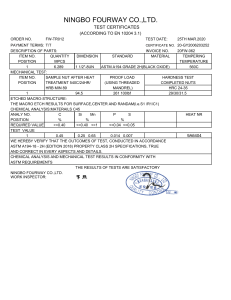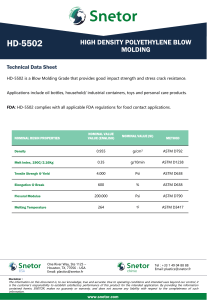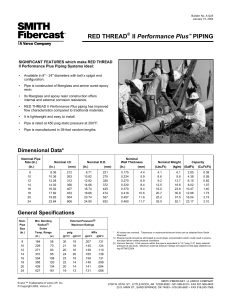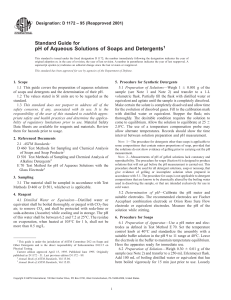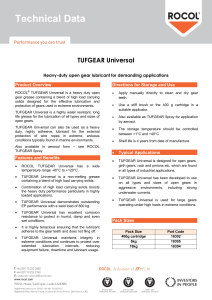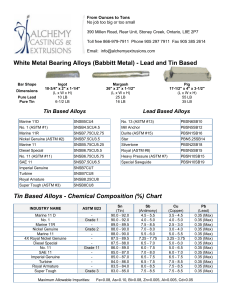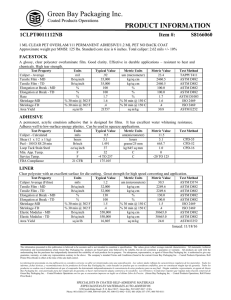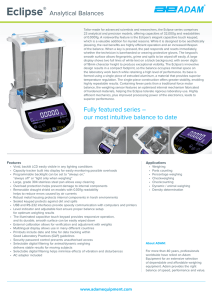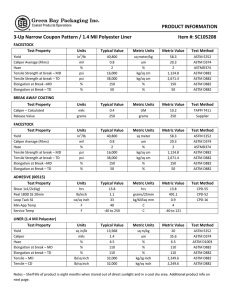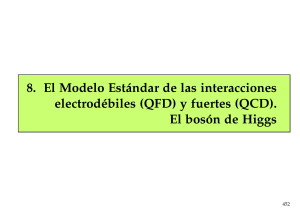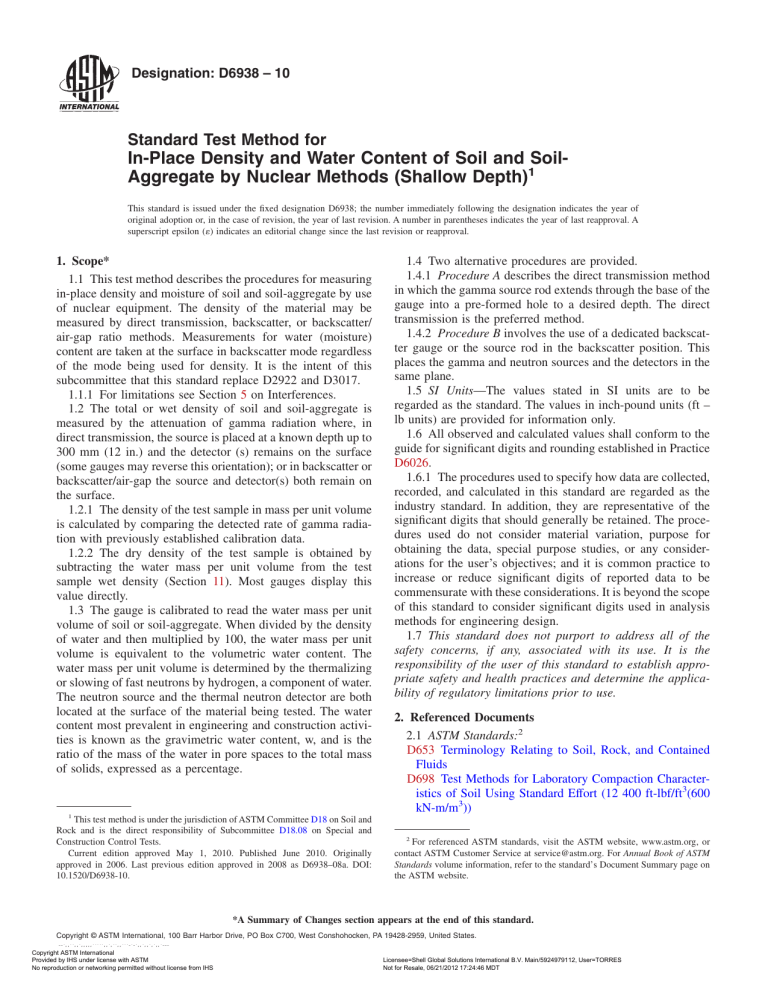
Designation: D6938 – 10 Standard Test Method for In-Place Density and Water Content of Soil and SoilAggregate by Nuclear Methods (Shallow Depth)1 This standard is issued under the fixed designation D6938; the number immediately following the designation indicates the year of original adoption or, in the case of revision, the year of last revision. A number in parentheses indicates the year of last reapproval. A superscript epsilon (´) indicates an editorial change since the last revision or reapproval. 1. Scope* 1.1 This test method describes the procedures for measuring in-place density and moisture of soil and soil-aggregate by use of nuclear equipment. The density of the material may be measured by direct transmission, backscatter, or backscatter/ air-gap ratio methods. Measurements for water (moisture) content are taken at the surface in backscatter mode regardless of the mode being used for density. It is the intent of this subcommittee that this standard replace D2922 and D3017. 1.1.1 For limitations see Section 5 on Interferences. 1.2 The total or wet density of soil and soil-aggregate is measured by the attenuation of gamma radiation where, in direct transmission, the source is placed at a known depth up to 300 mm (12 in.) and the detector (s) remains on the surface (some gauges may reverse this orientation); or in backscatter or backscatter/air-gap the source and detector(s) both remain on the surface. 1.2.1 The density of the test sample in mass per unit volume is calculated by comparing the detected rate of gamma radiation with previously established calibration data. 1.2.2 The dry density of the test sample is obtained by subtracting the water mass per unit volume from the test sample wet density (Section 11). Most gauges display this value directly. 1.3 The gauge is calibrated to read the water mass per unit volume of soil or soil-aggregate. When divided by the density of water and then multiplied by 100, the water mass per unit volume is equivalent to the volumetric water content. The water mass per unit volume is determined by the thermalizing or slowing of fast neutrons by hydrogen, a component of water. The neutron source and the thermal neutron detector are both located at the surface of the material being tested. The water content most prevalent in engineering and construction activities is known as the gravimetric water content, w, and is the ratio of the mass of the water in pore spaces to the total mass of solids, expressed as a percentage. 1 This test method is under the jurisdiction of ASTM Committee D18 on Soil and Rock and is the direct responsibility of Subcommittee D18.08 on Special and Construction Control Tests. Current edition approved May 1, 2010. Published June 2010. Originally approved in 2006. Last previous edition approved in 2008 as D6938–08a. DOI: 10.1520/D6938-10. 1.4 Two alternative procedures are provided. 1.4.1 Procedure A describes the direct transmission method in which the gamma source rod extends through the base of the gauge into a pre-formed hole to a desired depth. The direct transmission is the preferred method. 1.4.2 Procedure B involves the use of a dedicated backscatter gauge or the source rod in the backscatter position. This places the gamma and neutron sources and the detectors in the same plane. 1.5 SI Units—The values stated in SI units are to be regarded as the standard. The values in inch-pound units (ft – lb units) are provided for information only. 1.6 All observed and calculated values shall conform to the guide for significant digits and rounding established in Practice D6026. 1.6.1 The procedures used to specify how data are collected, recorded, and calculated in this standard are regarded as the industry standard. In addition, they are representative of the significant digits that should generally be retained. The procedures used do not consider material variation, purpose for obtaining the data, special purpose studies, or any considerations for the user’s objectives; and it is common practice to increase or reduce significant digits of reported data to be commensurate with these considerations. It is beyond the scope of this standard to consider significant digits used in analysis methods for engineering design. 1.7 This standard does not purport to address all of the safety concerns, if any, associated with its use. It is the responsibility of the user of this standard to establish appropriate safety and health practices and determine the applicability of regulatory limitations prior to use. 2. Referenced Documents 2.1 ASTM Standards:2 D653 Terminology Relating to Soil, Rock, and Contained Fluids D698 Test Methods for Laboratory Compaction Characteristics of Soil Using Standard Effort (12 400 ft-lbf/ft3(600 kN-m/m3)) 2 For referenced ASTM standards, visit the ASTM website, www.astm.org, or contact ASTM Customer Service at [email protected]. For Annual Book of ASTM Standards volume information, refer to the standard’s Document Summary page on the ASTM website. *A Summary of Changes section appears at the end of this standard. Copyright © ASTM International, 100 Barr Harbor Drive, PO Box C700, West Conshohocken, PA 19428-2959, United States. --`,,``,,`,,,,,`````,,`,``,,```-`-`,,`,,`,`,,`--- Copyright ASTM International Provided by IHS under license with ASTM No reproduction or networking permitted without license from IHS 1Licensee=Shell Global Solutions International B.V. Main/5924979112, User=TORRES Not for Resale, 06/21/2012 17:24:46 MDT D6938 – 10 3. Terminology 3.1 Definitions: See Terminology D653 for general definitions. 3.2 Definitions of Terms Specific to This Standard: 3.2.1 nuclear gauge—a device containing one or more radioactive sources used to measure certain properties of soil and soil-aggregates. 3.2.2 wet density—same as bulk density (as defined in Terminology D653); the total mass (solids plus water) per total volume of soil or soil-aggregate. 3.2.3 dry density—same as density of dry soil or rock (as defined in Terminology D653); the mass of solid particles per the total volume of soil or soil-aggregate. 3.2.4 gamma (radiation) source—a sealed source of radioactive material that emits gamma radiation as it decays. 3.2.5 neutron (radiation) source—a sealed source of radioactive material that emits neutron radiation as it decays. 3.2.6 Compton scattering—the interaction between a gamma ray (photon) and an orbital electron where the gamma ray loses energy and rebounds in a different direction. 3.2.7 detector—a device to detect and measure radiation. 3.2.8 probe—a metal rod attached to a nuclear gauge in which a radioactive source or a detector is housed. The rod can Copyright ASTM International Provided by IHS under license with ASTM No reproduction or networking permitted without license from IHS be lowered to specified depths for testing. Probes containing only a radioactive source are commonly referred to as “Source Rods.” 3.2.9 thermalization—the process of “slowing down” fast neutrons by collisions with light-weight atoms, such as hydrogen. 3.2.10 water content—the ratio of the mass of water contained in the pore spaces of soil or soil-aggregate, to the solid mass of particles in that material, expressed as a percentage (this is sometimes referred to in some scientific fields as gravimetric water content to differentiate it from volumetric water cotent). 3.2.11 volumetric water content—the volume of water as a percent of the total volume of soil or rock material. 3.2.12 test count, n—the measured output of a detector for a specific type of radiation for a given test. 3.2.13 prepared blocks—blocks prepared of soil, solid rock, concrete, and engineered materials, that have characteristics of various degrees of reproducible uniformity. 4. Significance and Use 4.1 The test method described is useful as a rapid, nondestructive technique for in-place measurements of wet density and water content of soil and soil-aggregate and the determination of dry density. 4.2 The test method is used for quality control and acceptance testing of compacted soil and soil-aggregate mixtures as used in construction and also for research and development. The nondestructive nature allows repetitive measurements at a single test location and statistical analysis of the results. 4.3 Density—The fundamental assumptions inherent in the methods are that Compton scattering is the dominant interaction and that the material is homogeneous. 4.4 Water Content—The fundamental assumptions inherent in the test method are that the hydrogen ions present in the soil or soil-aggregate are in the form of water as defined by the water content derived from Test Methods D2216, and that the material is homogeneous. (See 5.2) NOTE 1—The quality of the result produced by this standard test method is dependent on the competence of the personnel performing it, and the suitability of the equipment and facilities used. Agencies that meet the criteria of Practice D3740 are generally considered capable of competent and objective testing/sampling/inspection, and the like. Users of this standard are cautioned that compliance with Practice D3740 does not in itself assure reliable results. Reliable results depend on many factors; Practice D3740 provides a means of evaluating some of those factors. 5. Interferences 5.1 In-Place Density Interferences 5.1.1 Measurements may be affected by the chemical composition of the material being tested. 5.1.2 Measurements may be affected by non-homogeneous soils and surface texture (see 10.2). 5.1.3 Measurements in the Backscatter Mode are influenced more by the density and water content of the material in close proximity to the surface. 2Licensee=Shell Global Solutions International B.V. Main/5924979112, User=TORRES Not for Resale, 06/21/2012 17:24:46 MDT --`,,``,,`,,,,,`````,,`,``,,```-`-`,,`,,`,`,,`--- D1556 Test Method for Density and Unit Weight of Soil in Place by Sand-Cone Method D1557 Test Methods for Laboratory Compaction Characteristics of Soil Using Modified Effort (56,000 ft-lbf/ ft3(2,700 kN-m/m3)) D2167 Test Method for Density and Unit Weight of Soil in Place by the Rubber Balloon Method D2487 Practice for Classification of Soils for Engineering Purposes (Unified Soil Classification System) D2488 Practice for Description and Identification of Soils (Visual-Manual Procedure) D2216 Test Methods for Laboratory Determination of Water (Moisture) Content of Soil and Rock by Mass D2937 Test Method for Density of Soil in Place by the Drive-Cylinder Method D3740 Practice for Minimum Requirements for Agencies Engaged in Testing and/or Inspection of Soil and Rock as Used in Engineering Design and Construction D4253 Test Methods for Maximum Index Density and Unit Weight of Soils Using a Vibratory Table D4254 Test Methods for Minimum Index Density and Unit Weight of Soils and Calculation of Relative Density D4643 Test Method for Determination of Water (Moisture) Content of Soil by Microwave Oven Heating D4718 Practice for Correction of Unit Weight and Water Content for Soils Containing Oversize Particles D4944 Test Method for Field Determination of Water (Moisture) Content of Soil by the Calcium Carbide Gas Pressure Tester D4959 Test Method for Determination of Water (Moisture) Content of Soil By Direct Heating D6026 Practice for Using Significant Digits in Geotechnical Data D7013 Guide for Nuclear Surface Moisture and Density Gauge Calibration Facility Setup D6938 – 10 6. Apparatus 6.1 Nuclear Density / Moisture Gauge—While exact details of construction of the apparatus may vary, the system shall consist of: 6.1.1 Gamma Source—A sealed source of high-energy gamma radiation such as cesium or radium. 6.1.2 Gamma Detector—Any type of gamma detector such as a Geiger-Mueller tube(s). 6.1.3 Fast Neutron Source—A sealed mixture of a radioactive material such as americium, radium and a target material such as beryllium, or a neutron emitter such as californium252. 6.1.4 Slow Neutron Detector—Any type of slow neutron detector such as boron trifluoride or helium-3 proportional counter. 6.2 Reference Standard—A block of material used for checking instrument operation, correction of source decay, and to establish conditions for a reproducible reference count rate. 6.3 Site Preparation Device—A plate, straightedge, or other suitable leveling tool that may be used for planing the test site Copyright ASTM International Provided by IHS under license with ASTM No reproduction or networking permitted without license from IHS to the required smoothness, and in the Direct Transmission Method, guiding the drive pin to prepare a perpendicular hole. 6.4 Drive Pin—A pin of slightly larger diameter than the probe in the Direct Transmission Instrument used to prepare a hole in the test site for inserting the probe. 6.4.1 Drive Pin Guide—A fixture that keeps the drive pin perpendicular to the test site. Generally part of the site preparation device. 6.5 Hammer—Heavy enough to drive the pin to the required depth without undue distortion of the hole. 6.6 Drive Pin Extractor—A tool that may be used to remove the drive pin in a vertical direction so that the pin will not distort the hole in the extraction process. 6.7 Slide Hammer, with a drive pin attached, may also be used both to prepare a hole in the material to be tested and to extract the pin without distortion to the hole. 7. Hazards 7.1 These gauges utilize radioactive materials that may be hazardous to the health of the users unless proper precautions are taken. Users of these gauges must become familiar with applicable safety procedures and government regulations. 7.2 Effective user instructions, together with routine safety procedures and knowledge of and compliance with Regulatory Requirements, are a mandatory part of the operation and storage of these gauges. 8. Calibration 8.1 Calibration of the gauge will be in accordance with Annex A1 and Annex A2. 8.2 For further reference on gauge calibration, see Guide D7013, Standard Guide for Nuclear Surface Moisture and Density Gauge Calibration Facility Setup. 9. Standardization 9.1 Nuclear moisture density gauges are subject to longterm aging of the radioactive sources, which may change the relationship between count rates and the material density and water content. To correct for this aging effect, gauges are calibrated as a ratio of the measurement count rate to a count rate made on a reference standard or to an air-gap count (for the backscatter/air-gap ratio method). 9.2 Standardization of the gauge shall be performed at the start of each day’s use, and a record of these data should be retained for the amount of time required to ensure compliance with either subsection 9.2.2 or 9.2.3, whichever is applicable. Perform the standardization with the gauge located at least 9 m (30 ft) away from other nuclear moisture density gauges and clear of large masses of water or other items which can affect the reference count rates. 9.2.1 Turn on the gauge and allow for stabilization according to the manufacturer’s recommendations. 9.2.2 Using the reference standard, take a reading that is at least four times the duration of a normal measurement period (where a normal measurement period is typically one minute) to constitute one standardization check. Use the procedure recommended by the gauge manufacturer to establish the compliance of the standard measurement to the accepted range. 3Licensee=Shell Global Solutions International B.V. Main/5924979112, User=TORRES Not for Resale, 06/21/2012 17:24:46 MDT --`,,``,,`,,,,,`````,,`,``,,```-`-`,,`,,`,`,,`--- 5.1.4 Measurements in the Direct Transmission mode are an average of the density from the bottom of the probe in the soil or soil aggregate back up to the surface of the gauge. 5.1.5 Oversize particles or large voids in the source-detector path may cause higher or lower density measurements. Where lack of uniformity in the soil due to layering, aggregate or voids is suspected, the test site should be excavated and visually examined to determine if the test material is representative of the in-situ material in general and if an oversize correction is required in accordance with Practice D4718. 5.1.6 The measured volume is approximately 0.0028 m3(0.10 ft3) for the Backscatter Mode and 0.0057 m3(0.20 ft3) for the Direct Transmission Mode when the test depth is 150 mm (6 in.). The actual measured volume is indeterminate and varies with the apparatus and the density of the material. 5.1.7 Other radioactive sources must not be within 9 m (30 ft.) of equipment in operation. 5.2 In-Place Water (Moisture) Content Interferences 5.2.1 The chemical composition of the material being tested can affect the measurement and adjustments may be necessary (see Section 10.6). Hydrogen in forms other than water and carbon will cause measurements in excess of the true value. Some chemical elements such as boron, chlorine, and cadmium will cause measurements lower than the true value. 5.2.2 The water content measured by this test method is not necessarily the average water content within the volume of the sample involved in the measurement. Since this measurement is by backscatter in all cases, the value is biased by the water content of the material closest to the surface. The volume of soil and soil-aggregate represented in the measurement is indeterminate and will vary with the water content of the material. In general, the greater the water content of the material, the smaller the volume involved in the measurement. Approximately 50 % of the typical measurement results from the water content of the upper 50 to 75 mm (2 to 3 in.). 5.2.3 Other neutron sources must not be within 9 m (30 ft) of equipment in operation. D6938 – 10 Without specific recommendations from the gauge manufacturer, use the procedure in 9.2.3. 9.2.3 If the values of the current standardization counts are outside the limits set by Eq 1 and Eq 2, repeat the standardization check. If the second standardization check satisfies Eq 1 and Eq 2, the gauge is considered in satisfactory operating condition. –~ln~2!!t Td~1/2! # Nd0 # 1.01~Ndc!e –~ln~2!!t Tm~1/2! # Nm0 # 1.02~Nmc!e 0.99~Ndc!e –~ln~2!!t Td~1/2! (1) and 0.98~Nmc!e –~ln~2!!t Tm~1/2! (2) 9.3.1 For this example, a total of 245 days have elapsed between the date of calibration or verification (March 1) and the date of the gauge standardization (November 1). Therefore: t = 245 days Td(1/2)= 11 023 days Tm(1/2)= 157 788 days Ndc= 2800 counts Nmc= 720 counts 9.3.2 According to Eq 1, therefore, the lower limit for the density standard count taken on November 1, denoted by Nd0, is: 0.99~Ndc!e where: Td(1/2) --`,,``,,`,,,,,`````,,`,``,,```-`-`,,`,,`,`,,`--- = the half-life of the isotope that is used for the density determination in the gauge. For example, for 137Cs, the radioactive isotope most commonly used for density determination in these gauges, Td(1/2), is 11 023 days, Tm(1/2) = the half-life of the isotope that is used for the water content determination in the gauge. For example, for 241Am, the radioactive isotope in Am:Be, the radioactive source most commonly used for water content determination in these gauges, Tm(1/2), is 157 788 days, = the density system standardization count acNdc quired at the time of the last calibration or verification, = the moisture system standardization count acNmc quired at the time of the last calibration or verification, = the current density system standardization Nd0 count, = the current moisture system standardization Nm0 count, t = the time that has elapsed between the current standardization test and the date of the last calibration or verification. The units selected for t, Td(1/2), and Tm(1/2) should be consistent, that is, if Td(1/2) is expressed in days, then t should also be expressed in days, ln(2) = the natural logarithm of 2, which has a value of approximately 0.69315, e = the inverse of the natural logarithm function, which has a value of approximately 2.71828. 9.2.4 If for any reason the measured density or moisture becomes suspect during the day’s use, perform another standardization check. 9.3 Example—A nuclear gauge containing a 137Cs source for density determination (half-life = 11 023 days) and an 241Am:Be source for moisture determination (half-life = 157 788 days) is calibrated on March 1 of a specific year. At the time of calibration, the density standard count was 2800 counts per minute (prescaled), and the moisture standard count was 720 counts per minute (prescaled). According to Eq 1 and Eq 2 from Section 9.2.3, what is the allowed range of standard counts for November 1 of the same year? Copyright ASTM International Provided by IHS under license with ASTM No reproduction or networking permitted without license from IHS –~ln~2!!t Td~1/2! 5 0.99~2800!e –~ln~2!! · 245 11 023 5 2772e–0.01541 5 2730 counts 9.3.3 Likewise, the upper limit for the density standard count taken on November 1, denoted by Nd0, is: 1.01~Ndc!e –~ln~2!!t Td~1/2! 5 1.01~2800!e –~ln~2!! · 245 11 023 5 2828e–0.01541 5 2785 counts 9.3.4 Therefore, the density standard count acquired on November 1 should lie somewhere between 2730 and 2785 counts, or 2730 # Nd0# 2785. According to Eq 2, the lower limit for the moisture standard count taken on November 1, denoted by Nm0, is: 0.98~Nmc!e –~ln~2!!t Tm~1/2! 5 0.98~720!e –~ln~2!! · 245 157 788 5 706e–0.00108 5 705 counts 9.3.5 Likewise, the upper limit for the moisture standard count taken on November 1, denoted by Nd0, is: 1.02~Nmc!e –~ln~2!!t Tm~1/2! 5 1.02~720!e –~ln~2!! · 245 157 788 5 734e–0.00108 5 733 counts 9.3.6 Therefore, the moisture standard count acquired on November 1 should lie somewhere between 705 and 733 counts, or 705 # Nm0# 733. 10. Procedure 10.1 When possible, select a test location where the gauge will be placed at least 600 mm (24.0 in) away from any object sitting on or projecting above the surface of the test location, when the presence of this object has the potential to modify gauge response. Any time a measurement must be made at a specific location and the aforementioned clearance cannot be achieved, such as in a trench, follow the gauge manufacturer’s correction procedure(s). 10.2 Prepare the test site in the following manner: 10.2.1 Remove all loose and disturbed material and additional material as necessary to expose the true surface of the material to be tested. 10.2.2 Prepare an area sufficient in size to accommodate the gauge by grading or scraping the area to a smooth condition so as to obtain maximum contact between the gauge and material being tested. 10.2.3 The depth of the maximum void beneath the gauge shall not exceed 3 mm (1⁄8 in.). Use native fines or fine sand to fill the voids and smooth the surface with a rigid straight edge or other suitable tool. The depth of the filler should not exceed approximately 3 mm (1⁄8 in.). 4Licensee=Shell Global Solutions International B.V. Main/5924979112, User=TORRES Not for Resale, 06/21/2012 17:24:46 MDT D6938 – 10 NOTE 2—Care must be taken in the preparation of the access hole in uniform cohesionless granular soils. Measurements can be affected by damage to the density of surrounding materials when forming the hole. 10.4.5 Place the gauge on the material to be tested, ensuring maximum surface contact as described previously in 10.2.4. 10.4.6 Lower the probe into the hole to the desired test depth. Pull the gauge gently toward the back, or detector end, so that the back side of the probe is in intimate contact with the side of the hole in the gamma measurement path. NOTE 3—As a safety measure, it is recommended that a probe containing radioactive sources not be extended out of its shielded position prior to placing it into the test site. When possible, align the gauge so as to allow placing the probe directly into the test hole from the shielded position. 10.4.7 Keep all other radioactive sources at least 9 m (30 feet) away from the gauge to avoid any effect on the measurement. 10.4.8 If the gauge is so equipped, set the depth selector to the same depth as the probe. 10.4.9 Secure and record one or more one-minute density and water content readings. Read the in-place wet density directly or determine one by use of the calibration curve or table previously established. 10.4.10 Read the water content directly or determine the water content by use of the calibration curve or table previously established. 10.5 Procedure B -The Backscatter or Backscatter/Air-Gap Ratio Procedure: 10.5.1 Seat the gauge firmly (see Note 2). 10.5.2 Keep all other radioactive sources at least 9m (30 ft) away from the gauge to avoid affecting the measurement. 10.5.3 Set the gauge into the Backscatter (BS) position. 10.5.4 Secure and record one or more set(s) of one-minute density and water content readings. When using the Copyright ASTM International Provided by IHS under license with ASTM No reproduction or networking permitted without license from IHS backscatter/air-gap ratio mode, follow the manufacturer’s instructions regarding gauge setup. Take the same number of readings for the normal measurement period in the air-gap position as in the standard backscatter position. Calculate the air-gap ratio by dividing the counts per minute obtained in the air-gap position by the counts per minute obtained in the standard position. Many gauges have built-in provisions for automatically calculating the air-gap ratio and wet density. 10.5.5 Read the in-place wet density or determine one by use of the calibration curve or table previously established. 10.5.6 Read the water content or determine one by use of the calibration curve or previously established table (see Section 10.6). 10.6 Water Content Correction and Oversize Particle Correction 10.6.1 For proper use of the gauge and accurate values of both water content and dry density, both of these corrections need to be made when applicable. Prior to using the gauge-derived water content on any new material, the value should be verified by comparison to another ASTM method such as Test Methods D2216, D4643, D4944, or D4959. As part of a user developed procedure, occasional samples should be taken from beneath the gauge and comparison testing done to confirm gauge-derived water content values. All gauge manufacturers have a procedure for correcting the gauge-derived water content values. 10.6.2 When oversize particles are present, the gauge can be rotated about the axis of the probe to obtain additional readings as a check. When there is any uncertainty as to the presence of these particles it is advisable to sample the material beneath the gauge to verify the presence and the relative proportion of the oversize particles. A rock correction can then be made for both water content and wet density by the method in Practice D4718. 10.6.3 When sampling for water content correction or oversize particle correction, the sample should be taken from a zone directly under the gauge. The size of the zone is approximately 200 mm (8 in.) in diameter and a depth equal to the depth setting of the probe when using the direct transmission mode; or approximately 75 mm (3 in.) in depth when using the backscatter mode. 11. Calculation of Results 11.1 Determine the Wet Density 11.1.1 On most gauges read the value directly in kg/m3(lbm/ 3 ft ). If the density reading is in “counts”, determine the in-place wet density by use of this reading and the previously established calibration curve or table for density. 11.1.2 Record the density to the nearest 1 kg/m3(0.1 lbm/ 3 ft ). 11.2 Water Content 11.2.1 Use the gauge reading for w if the gauge converts to that value. 11.2.2 If the gauge determines water mass per unit volume in kg/m3(lbm / ft3), calculate w using the formula: w5 Mm 3 100 rd or, 5Licensee=Shell Global Solutions International B.V. Main/5924979112, User=TORRES Not for Resale, 06/21/2012 17:24:46 MDT (3) --`,,``,,`,,,,,`````,,`,``,,```-`-`,,`,,`,`,,`--- 10.2.4 The placement of the gauge on the surface of the material to be tested is critical to accurate density measurements. The optimum condition is total contact between the bottom surface of the gauge and the surface of the material being tested. The total area filled should not exceed approximately 10 percent of the bottom area of the gauge. 10.3 Turn on and allow the gauge to stabilize (warm up) according to the manufacturer’s recommendations (see Section 9.2.1). 10.4 Procedure A - The Direct Transmission Procedure: 10.4.1 Select a test location where the gauge in test position will be at least 150 mm (6 in.) away from any vertical projection 10.4.2 Make a hole perpendicular to the prepared surface using the rod guide and drive pin. The hole should be a minimum of 50 mm (2 inches) deeper than the desired measurement depth and of an alignment that insertion of the probe will not cause the gauge to tilt from the plane of the prepared area. 10.4.3 Mark the test area to allow the placement of the gauge over the test site and to align the source rod to the hole. Follow the manufacturer’s recommendations if applicable. 10.4.4 Remove the hole-forming device carefully to prevent the distortion of the hole, damage to the surface, or loose material to fall into the hole. D6938 – 10 (4) where: w = water content = dry density in kg/m3 or (lbm/ft3), rd r = wet density in kg/m3 or (lbm/ft3), and Mm = water mass per unit volume in kg/m3 or (lbm/ft3) 11.2.3 If the water content reading was in “counts,” determine the water mass per unit volume by use of this reading and previously established calibration curve or table. Then convert to gravimetric water content as per 11.2.2. 11.2.4 Record water content to the nearest 0.1 %. 11.3 Determine the Dry Density of the soil by one of the following methods: 11.3.1 If the water content is obtained by nuclear methods, use the gauge readings directly for dry density in kg/m3(lbm/ ft3). The value can also be calculated from: rd 5 r 2 M m (5) 11.3.2 If the water content is to be determined from a sample of soil taken as prescribed in (10.6.3), follow the procedures and perform the calculations of the chosen Test Method (D2216, D4643, D4944, or D4959). 11.3.3 With a water content value from 11.3.2 calculate the dry density from: 100 3 r rd 5 100 1 w (6) 11.3.4 Report the dry density to the nearest 1 kg/m3(0.1 lbm/ft3). 11.4 Determine the Percent Compaction: 11.4.1 It may be desired to express the in-place dry density as a percentage of a laboratory density such as Test Methods D698, D1557, D4253, or D4254. This relationship can be calculated by dividing the in-place dry density by the laboratory maximum dry density and multiplying by 100. Procedures for calculating relative density are provided in Test Method D4254 which requires that Test Method D4253 also be performed. Corrections for oversize material, if required, should be performed in accordance with Practice D4718. 12. Report: Test Data Sheet(s)/Form(s)/Final Report(s) 12.1 The Field Data Records shall include, as a minimum, the following: 12.1.1 Test Number or Test Identification. 12.1.2 Location of test (for example, Station number or GPS or Coordinates or other identifiable information). 12.1.3 Visual description of material tested. 12.1.4 Lift number or elevation or depth. 12.1.5 Name of the operator(s). 12.1.6 Make, model and serial number of the test gauge. 12.1.7 Test mode, Method A (direct transmission and test depth), or Method B (backscatter, backscatter/air-gap), 12.1.8 Standardization and adjustment data for the date of the tests. 12.1.9 Any corrections made in the reported values and reasons for these corrections (that is, over-sized particles, water content). Copyright ASTM International Provided by IHS under license with ASTM No reproduction or networking permitted without license from IHS 12.1.10 Maximum laboratory density value in kg/m3 or lbm/ft3. 12.1.11 Dry density in kg/m3 or lbm/ft3. 12.1.12 Wet density in kg/m3 or lbm/ft3. 12.1.13 Water content in percent. 12.1.14 Percent Compaction. 12.2 Final Report (minimum required information): 12.2.1 Test Number. 12.2.2 Gauge Serial number. 12.2.3 Location of test (for example, Station number or GPS or Coordinates or other identifiable information). 12.2.4 Lift number or elevation or depth. 12.2.5 Moisture (Water) content as a percent. 12.2.6 Maximum laboratory density value in kg/m3 or lbm/ft3. 12.2.7 Dry Density result in kg/m3 or lbm/ft3. 12.2.8 Percent Compaction. 12.2.9 Name of Operator(s). 13. Precision and Bias 13.1 Precision: 13.1.1 Precision: Wet Density—Criteria for judging the acceptability of wet density test results obtained by this test method are given in Table 1.3 The values given are based upon an interlaboratory study in which five test sites containing soils, with wet densities as shown in column two were tested by eight different nuclear gauges and operators. The wet density of each test site was measured three times by each device. 13.1.2 Precision: Water Mass Per Unit Volume—Criteria for judging the acceptability of the water mass per unit volume results obtained by this test method are given in Table 2. The values given are based upon an inter-laboratory study in which five test sites containing soils with water mass per unit volume as shown in column two were tested by eight different nuclear gauges and operators. The water mass per unit volume of each test site was measured three times by each device. 13.1.3 Precision: Water Content—Criteria for judging the acceptability of the water content results obtained by this test method are given in Table 3. The values given are based upon an inter-laboratory study in which five test sites containing soils, with water content as shown in column two were tested by eight different nuclear gauges and operators. The water content of each test site was measured three times by each device. 13.2 Bias: 13.2.1 There are no accepted reference values for these test methods, therefore, bias cannot be determined 14. Keywords 14.1 Compaction test; acceptance testing; construction control; quality control; field density; in-place density; wet density; water content; dry density; nuclear methods, nuclear gauge 3 Supporting data have been filed at ASTM International Headquarters and may be obtained by requesting Research Report RR:D18-1004. 6Licensee=Shell Global Solutions International B.V. Main/5924979112, User=TORRES Not for Resale, 06/21/2012 17:24:46 MDT --`,,``,,`,,,,,`````,,`,``,,```-`-`,,`,,`,`,,`--- Mm 3 100 w5 r2M m D6938 – 10 TABLE 1 Results of Statistical Analysis (Wet Density)A Direct Transmission: MaterialB Average kg/m3 or (lbm/ft3) Repeatability Standard Deviation kg/m3 or (lbm/ft3) ML CL SP 2084 (130.1) 1837 (114.7) 1937 (120.9) 7.4 (0.46) 5.4 (0.34) 4.2 (0.26) MaterialB Average kg/m3 or (lbm/ft3) Repeatability Standard Deviation kg/m3 or (lbm/ft3) ML 1997 (124.6) 16.0 (1.00) Reproducibility Standard Deviation kg/m3 or (lbm/ft3) 95 % Repeatability Limit on the Difference Between Two Test Results kg/m3 or (lbm/ft3)C 95 % Reproducibility Limit on the Difference Between Two Test Results kg/m3 or (lbm/ft3)C 12.3 (0.77) 10.6 (0.66) 11.0 (0.68) 21 (1.3) 15 (0.9) 12 (0.7) 34 (2.1) 30 (1.9) 31 (1.9) Reproducibility Standard Deviation kg/m3 or (lbm/ft3) 95 % Repeatability Limit on the Difference Between Two Test Results kg/m3 or (lbm/ft3)C 95 % Reproducibility Limit on the Difference Between Two Test Results kg/m3 or (lbm/ft3)C 32.0 (2.00) 45 (2.8) 90 (5.6) Backscatter: A The data used to establish this precision statement are contained in a Research Report available from ASTM Headquarters.3 B Materials are distinguished by soil types. For definitions of soil types see Practices D2487 and D2488. C Two separate readings at a singular site with constant gauge orientation and settings. TABLE 2 Results of Statistical Analysis (Water Mass Per Unit Volume)A B Material Average kg/m3 or (lbm/ft3) Repeatability Standard Deviation kg/m3 or (lbm/ft3) Reproducibility Standard Deviation kg/m3 or (lbm/ft3) 95 % Repeatability Limit on the Difference Between Two Test Results kg/m3 or (lbm/ft3)C 95 % Reproducibility Limit on the Difference Between Two Test Results kg/m3 or (lbm/ft3)C ML CL SP 313 (19.6) 193 (12.1) 320 (20.0) 5.7 (0.36) 6.1 (0.38) 4.3 (0.27) 8.1 (0.50) 8.5 (0.53) 10.3 (0.64) 16 (1.0) 17 (1.1) 12 (0.7) 23 (1.4) 24 (1.5) 29 (1.8) A The data used to establish this precision statement are contained in a Research Report available from ASTM Headquarters.3 Materials are distinguished by soil types. For definitions of soil types see Practices D2487 and D2488. C Two separate readings at a singular site with constant gauge orientation and settings. B TABLE 3 Results of Statistical Analysis (% Water Content)A MaterialB Average % Repeatability Standard Deviation % Reproducibility Standard Deviation % 95 % Repeatability Limit on the Difference Between Two Test Results %C 95 % Reproducibility Limit on the Difference Between Two Test Results %C ML CL SP 17.7 11.8 19.8 0.39 0.40 0.32 0.59 0.58 0.81 1.1 1.1 0.9 1.7 1.6 2.3 A The data used to establish this precision statement are contained in a Research Report available from ASTM Headquarters.3 Materials are distinguished by soil types. For definitions of soil types see Practices D2487 and D2488. C Two separate readings at a singular site with constant gauge orientation and settings. B ANNEXES --`,,``,,`,,,,,`````,,`,``,,```-`-`,,`,,`,`,,`--- (Mandatory Information) A1. WET DENSITY CALIBRATION & VERIFICATION A1.1 Calibration: Gauges shall be calibrated initially and after any repairs that can affect the gauge geometry or the existing calibration. To be within specified tolerances by procedures described in A1.2, calibration curves, tables, or equivalent coefficients shall be verified, at periods not to exceed 12 months. At any time these tolerances cannot be met, the gauge shall be calibrated to establish new calibration curves, tables, or equivalent coefficients. If the owner does not Copyright ASTM International Provided by IHS under license with ASTM No reproduction or networking permitted without license from IHS establish a verification procedure, the gauge shall be calibrated at a period not to exceed 12 months. A1.1.1 Gauge Calibration Response shall be within 6 16 kg/m3(6 1.0 lbm/ft3) on the block(s) on which the gauge was calibrated. This calibration may be done by the manufacturer, the user, or an independent vendor. Nuclear gauge response is influenced by the chemical composition of measured materials. 7Licensee=Shell Global Solutions International B.V. Main/5924979112, User=TORRES Not for Resale, 06/21/2012 17:24:46 MDT D6938 – 10 NOTE A1.1—Changes in background conditions or locations of blocks used for gauge calibrations or verification of calibrations can impact measurements on those blocks. Care must be taken to ensure uniform conditions when performing gauge calibrations or verifying gauge calibrations. A1.1.3 Sufficient data shall be taken on each density block to ensure a gauge count precision of at least one-half the gauge count precision required for field use assuming field use measurement of one minute duration and four-minute duration used for calibration, or an equivalent relationship. The data may be presented in the form of a graph, table, equation coefficients, or stored in the gauge, to allow converting the count rate data to density. A1.1.4 The method and test procedures used in establishing the calibration count rate data shall be the same as those used for obtaining the field count rate data. A1.1.5 The material type, actual density, or established density of each calibration block used to establish or verify the gauge calibration shall be stated as part of the calibration data for each measurement depth. If the actual or established block density varies with measurement depth, then the density data for each measurement depth shall be stated as part of the calibration. A1.1.6 The calibration blocks should be sufficient in size so that the count rate will not change if the block is enlarged in any dimension. NOTE A1.2—Minimum surface dimensions of approximately 610 mm by 430 mm (24 3 17 inches), have proven satisfactory. For the backscatter method a minimum depth of 230 mm (9 inches) is adequate; while for the direct transmission method the depth should be at least 50 mm (2 inches) deeper than the deepest rod penetration depth. A larger surface area should be considered for the backscatter/air-gap method. For blocks with widths or lengths smaller than the sizes specified, follow the block manufacturer’s recommendations for proper installation and use. The most successful blocks that have been established for calibration have been made of magnesium, aluminum, aluminum/magnesium, granite, and limestone. These blocks have been used in combination with each other, with historical curve information, and with other prepared block(s) to produce accurate and reliable calibration. A1.2 Verification: The method used for verification should be capable of confirming the accuracy of the general calibration curve representing the density range of the materials to be tested in the field. The verification process and the resulting tolerances obtained over the depths at which the gauge will be used, shall be formally recorded and documented. If this verification process indicates a variance beyond the specified tolerances, the gauge shall be calibrated A1.2.1 Gauge verification response shall be within 632 kg/m3(62.0 lbm/ft3) on block(s) of established density at each calibration depth. A1.2.2 Using the procedure described in either A3.1.1 or A3.1.2, ensure a gauge count precision of at least one-half the gauge count precision required for field use, assuming field use measurement of one-minute duration and four-minute duration are used for calibration, or an equivalent relationship. A1.2.3 The gauge calibration may be verified on calibration block(s) which were used for calibration of the gauge, or prepared blocks. A1.2.4 Prepared block(s) of soil, solid rock, concrete, and engineered block(s) that have characteristics of reproducible uniformity may be used, but care must be taken to establish density values and to minimize changes in density and water content over time. A1.2.5 Density values of prepared block(s) shall be determined in such a manner that the estimated standard deviation of the measurement results shall not exceed 0.5 % of the measured block density value. A1.2.6 Reestablish or verify density values for prepared block(s) of soil, solid rock, or concrete that have the potential of changes over time in density or moisture content at periods not exceeding 12 months. A1.2.7 The method used to establish or verify the block(s) density values shall be stated as part of the verification data. A1.2.8 All gauges shall be verified or calibrated at a minimum frequency of 12 months. --`,,``,,`,,,,,`````,,`,``,,```-`-`,,`,,`,`,,`--- This response must be taken into account in establishing the block density. The method used for calibration shall be capable of generating a general curve covering the entire density range of the materials to be tested in the field. The density of the block(s) shall be determined in such a manner that the estimated standard deviation of the measurement results shall not exceed 0.2 % of the measured block density. A1.1.2 Reestablish or verify the density of the block(s) used to calibrate or verify calibrations at a period not to exceed 5 years. The density values of the established block(s) of materials that have the potential for changes over time in density or moisture content, such as soil, concrete, or solid rock, shall be reestablished or verified at periods not exceeding 12 months. A2. WATER CONTENT CALIBRATION and VERIFICATION A2.1 Calibration: Gauges shall be calibrated initially and after any repairs that can affect the gauge geometry or the existing calibration. Calibration curves, tables, or equivalent coefficients shall be verified at periods, not exceeding 12 months, to be within specified tolerances by procedures described in A2.2. At any time these tolerances cannot be met, the gauge shall be calibrated to establish new calibration curves, tables, or equivalent coefficients. If the owner does not estab- Copyright ASTM International Provided by IHS under license with ASTM No reproduction or networking permitted without license from IHS lish a verification procedure, the gauge shall be calibrated at a period not to exceed 12 months. A2.1.1 Gauge Calibration Response shall be within 16 kg/m3(1 lbm/ft3) on the block(s) on which the gauge was calibrated. This calibration may be done by the gauge manufacturer, the user, or an independent vendor. The block(s) used for calibration should be capable of generating a general curve 8Licensee=Shell Global Solutions International B.V. Main/5924979112, User=TORRES Not for Resale, 06/21/2012 17:24:46 MDT D6938 – 10 NOTE A2.1—Dimensions of approximately 610 mm long by 460 mm wide by 200 mm deep (approximately 24 by 18 by 8 inches) have proven satisfactory. For blocks with width or length smaller than the sizes specified, follow block manufacturer’s recommendations for proper installation and use. A2.1.4 Prepare a homogeneous block of hydrogenous materials having an equivalent water mass per unit volume value determined by comparison (using a nuclear instrument) with a saturated silica sand standard prepared in accordance with A2.1.3. Metallic blocks used for wet density calibration such as magnesium or aluminum are a convenient zero water mass per unit volume block. A block of alternating sheets of aluminum or magnesium and polyethylene is convenient for a high water mass per unit volume block. A2.1.5 Prepare containers of compacted material with a water content determined by oven dry (Test Method D2216) and a wet density calculated from the mass of the material and the inside dimensions of the container. The water mass per unit volume may be calculated as follows: r3w Mm 5 100 1 w (A2.1) Where: Mm = water mass per unit volume, kg/m3 or lbm/ft3, w = water content, percent of dry mass, and r = wet (total) density, kg/m3 or lbm/ft3. A2.1.6 Where neither of the previous calibration standards are available, the gauge may be calibrated by using a minimum of three selected test sites in an area of a compaction project where material has been placed at several different water contents. The test sites shall represent the range of water contents over which the calibration is to be used. At least three replicate nuclear measurements shall be made at each test site. The density at each site shall be verified by measurements with calibrated equipment in accordance with the procedures described in this standard, Test Methods D1556, D2167, or D2937. The water content of the material at each of the test sites shall be determined using Test Method D2216. Use the mean value of the replicate readings as the calibration point value for each test site. A2.2 Verification: The method used for verification should be capable of confirming the accuracy of the general calibration curve representing the water content of the materials to be tested in the field. The verification process and resultant tolerances obtained shall be formally recorded and documented. If the verification process indicates a variance beyond the specified tolerances, new calibration curves, tables, or equivalent coefficients shall be established. A2.2.1 Verify an existing calibration by taking sufficient number of counts on one or more blocks of established water content to ensure the accuracy of the existing calibration within 616 kg/m3 or (61 lbm/ft3). The water content block(s) should be prepared in accordance with section A2.1.4 and A2.1.5 A2.2.2 Sufficient data shall be taken to ensure a gauge count precision of at least one half the gauge count precision required for field use assuming field use measurement of one minute duration and four minute duration used for calibration, or an equivalent relationship. A2.2.3 Calibration block(s) used to establish calibration parameters and prepared blocks can be used to verify calibration. A2.2.4 Prepared block(s) that have characteristics of reproducible uniformity can be used, but care must be taken to minimize changes in density and water content over time. A2.2.5 The established water content of the block(s) used for verification of the gauge shall be stated as part of the verification data. A2.2.6 All gauges shall be verified or calibrated at a minimum frequency of 12 months. A3. GAUGE PRECISION A3.1 Gauge precision is defined as the change in density or water mass per unit volume that occurs corresponding to a one standard deviation change in the count due to the random decay of the radioactive source. The density of the material and time period of the count must be stated. Calculate using the methods in either A3.1.1 or A3.1.2. For wet density , use a material having a density of 2000 6 80 kg/m3(125.0 6 5.0 lbm/ft3). Typical values of P are < 10 Copyright ASTM International Provided by IHS under license with ASTM No reproduction or networking permitted without license from IHS kg/m3(0.6 lbm/ft3) in backscatter or backscatter/air-gap; and < 5 kg/m3(0.3 lbm/ft3) for direct transmission measured at a 15 cm (6 in) depth. Use a water mass per unit volume value of 160 6 10 kg/m3(10.0 6 0.6 lbm/ft3) for determining slope and count rates. The value of P is typically less than 4.8 kg/m3(0.3 lbm/ft3). A3.1.1 Gauge Precision - Slope Method 9Licensee=Shell Global Solutions International B.V. Main/5924979112, User=TORRES Not for Resale, 06/21/2012 17:24:46 MDT --`,,``,,`,,,,,`````,,`,``,,```-`-`,,`,,`,`,,`--- covering the entire water content range of the materials to be tested in the field. The calibration curve can be established using counts and water contents of standard blocks, previous factory curve information, or historical data. Due to the effect of chemical composition, the calibration supplied by the manufacturer with the gauge will not be applicable to all materials. It shall be accurate for silica and water; therefore, the calibration must be verified and adjusted, if necessary, in accordance with section A2.2 A2.1.2 Reestablish or verify the assigned water content of blocks used to calibrate or verify calibrations at periods which shall be recommended by the block manufacturer. The water content values of blocks prepared of materials that have the potential of changes over time in density or moisture content, such as soil, concrete, or solid rock, shall be reestablished or verified at periods not exceeding 12 months. A2.1.3 All calibration blocks should be sufficient in size so that the count rate will not change if the block is enlarged in any dimension. D6938 – 10 Determine the gauge precision of the system, P, from the slope of the calibration curve, S, and the standard deviation, s, of the signals (detected gamma rays or detected neutrons) in counts per minute (cpm), as follows: P 5 s/S (A3.1) where: P = precision s = standard deviation, cpm S = slope, cpm/kg/m3 or cpm/lbm/ft3 NOTE A3.1—Displayed gauge counts may be scaled. Contact the manufacturer to obtain the appropriate pre-scale factor. A3.1.2 Gauge Precision – Repetitive Method Determine the standard deviation of a minimum of 20 repetitive readings of one minute each, without moving the gauge between readings. Calculate the standard deviation of the resulting readings. This is the gauge precision. A4. FIELD MOISTURE CONTENT ADJUSTMENTS A4.1 The calibration should be checked prior to performing tests on materials that are distinctly different from material types previously used in obtaining or adjusting the calibration. Sample materials may be selected by either A2.1.5 or A2.1.6. The amount of water shall be within 62 % of the water content established as optimum for compaction for these materials. Determine the water content w. A microwave oven or direct heater may be utilized for drying materials that are not sensitive to combustion of organic material, in addition to the method listed in A2.1.6. A minimum of three comparisons is recommended and the mean of the observed differences used as the correction factor. A4.2 Container(s) of compacted material taken from the test site shall be prepared in accordance with A2.1.5. A4.3 Test site(s) or the compacted material shall be selected in accordance with the procedures in A2.1.6. A4.4 The method and test procedures used in obtaining the count rate to establish the error must be the same as those used for measuring the water content of the material to be tested. A4.5 The mean value of the difference between the moisture content of the test samples as determined in A2.1.5 or A2.1.6 and the values measured with the gauge shall be used as a correction to measurements made in the field. Many gauges utilizing a microprocessor have provision to input a correction factor that is established by the relative values of water content as a percentage of dry density, thus eliminating the need to determine the difference in mass units of water. SUMMARY OF CHANGES Committee D18 has identified the location of selected changes to this standard since the last issue, D6938–08a, that may impact the use of this standard. (Approved May 1, 2010) (1) Revised Section 13 Precision and Bias to include a table of single-operator and multi-laboratory precision values for the measurement quantity water mass per unit volume. Revised significant digits in this section for consistency with Practice E29. (2) Added new Table 2 and renumbered subsequent tables. (3) Revised Table 1 and Table 3 for consistency with Practice E691. ASTM International takes no position respecting the validity of any patent rights asserted in connection with any item mentioned in this standard. Users of this standard are expressly advised that determination of the validity of any such patent rights, and the risk of infringement of such rights, are entirely their own responsibility. This standard is copyrighted by ASTM International, 100 Barr Harbor Drive, PO Box C700, West Conshohocken, PA 19428-2959, United States. Individual reprints (single or multiple copies) of this standard may be obtained by contacting ASTM at the above address or at 610-832-9585 (phone), 610-832-9555 (fax), or [email protected] (e-mail); or through the ASTM website (www.astm.org). Permission rights to photocopy the standard may also be secured from the ASTM website (www.astm.org/ COPYRIGHT/). Copyright ASTM International Provided by IHS under license with ASTM No reproduction or networking permitted without license from IHS 10 Licensee=Shell Global Solutions International B.V. Main/5924979112, User=TORRES Not for Resale, 06/21/2012 17:24:46 MDT --`,,``,,`,,,,,`````,,`,``,,```-`-`,,`,,`,`,,`--- This standard is subject to revision at any time by the responsible technical committee and must be reviewed every five years and if not revised, either reapproved or withdrawn. Your comments are invited either for revision of this standard or for additional standards and should be addressed to ASTM International Headquarters. Your comments will receive careful consideration at a meeting of the responsible technical committee, which you may attend. If you feel that your comments have not received a fair hearing you should make your views known to the ASTM Committee on Standards, at the address shown below.
